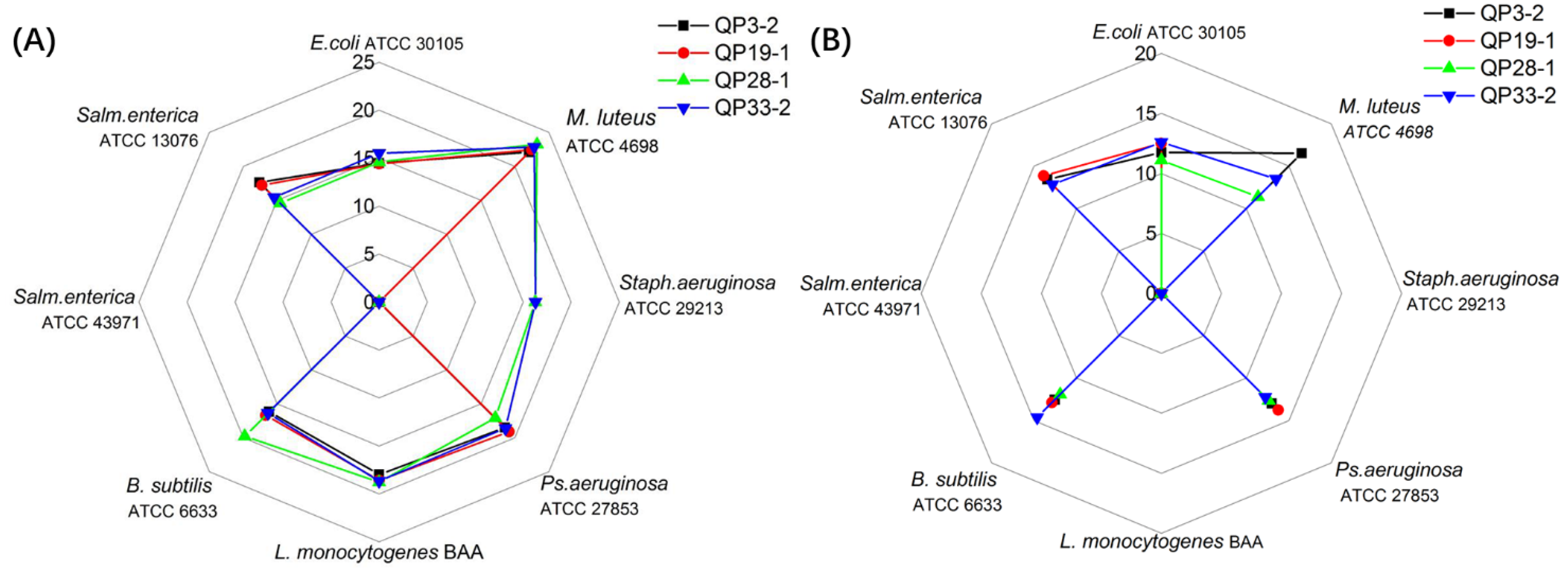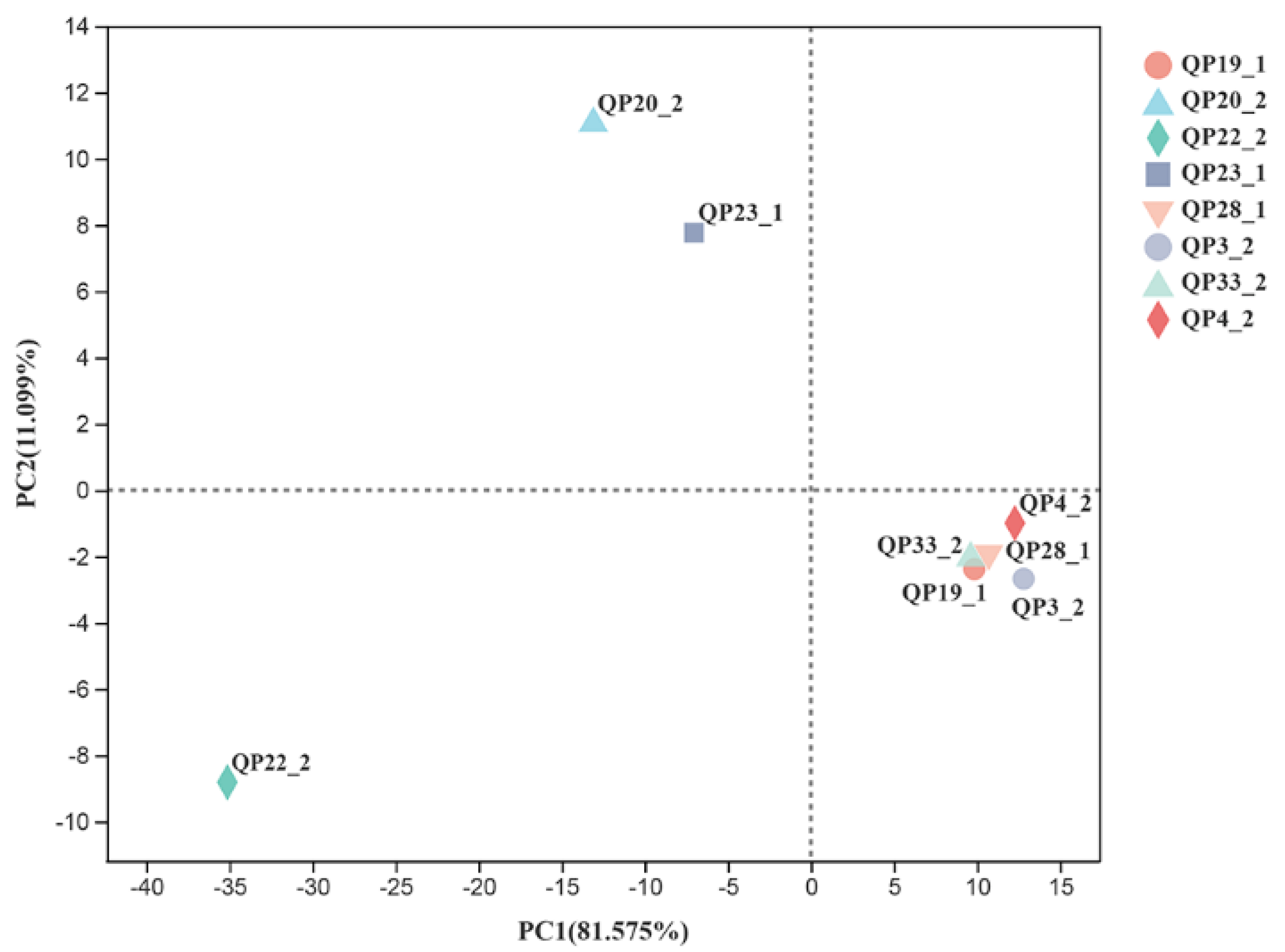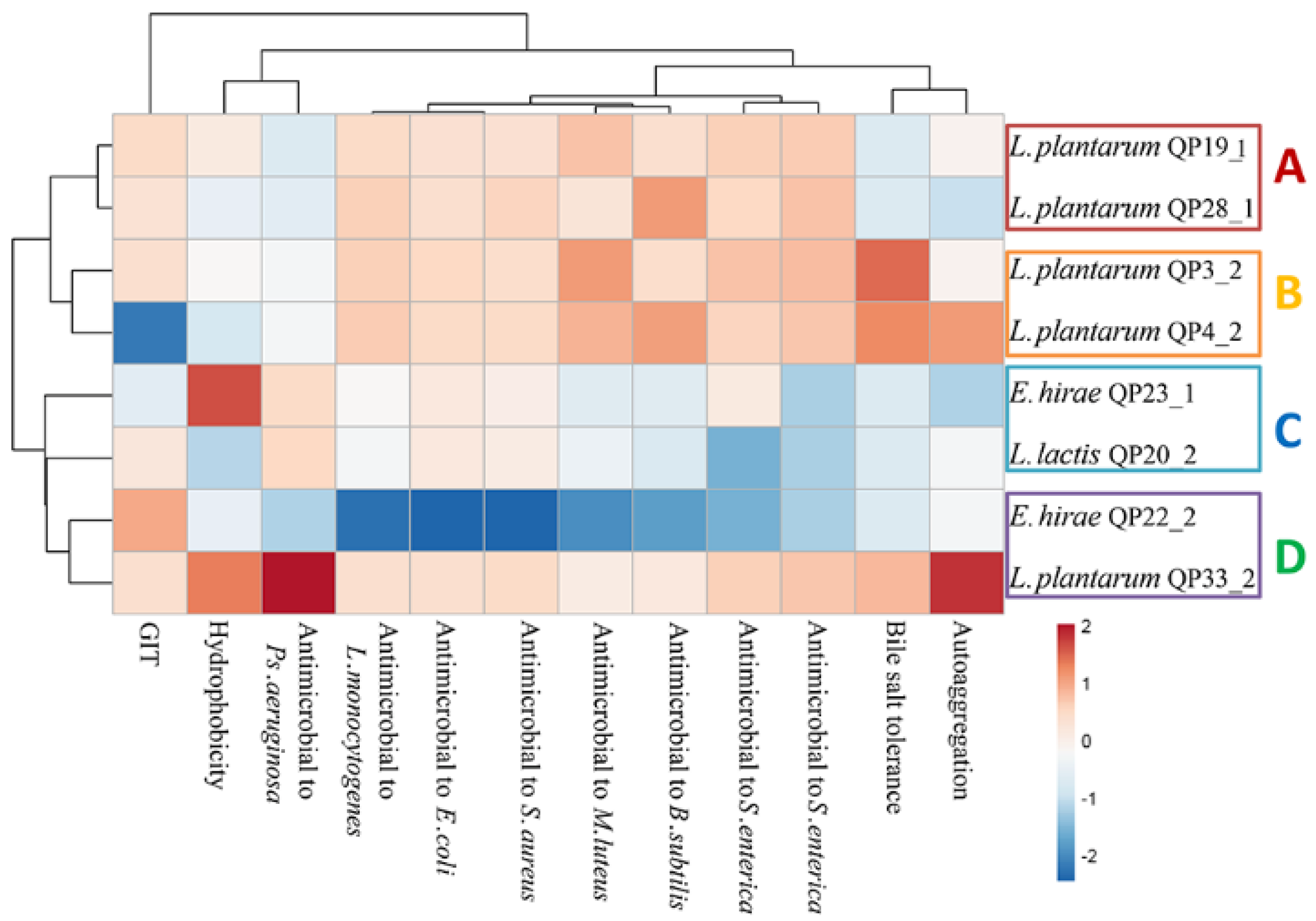Bacteriocin-Producing Lactic Acid Bacteria Strains with Antimicrobial Activity Screened from Bamei Pig Feces
Abstract
:1. Introduction
2. Materials and Methods
2.1. Sample Collection and Isolation of LAB Strains from Bamei Pigs
2.2. Screening of the Strains with Broad-Spectrum Antibacterial Activity
2.3. Identification of the Selected Strains by 16S rRNA Gene Sequence Analysis
2.4. Physiological and Biochemical Characteristics and Tolerance
2.5. Cell Surface Hydrophobicity and the Auto-Aggregation Assay
2.6. Screening of the LAB Strains Producing Broad-Spectrum Antibacterial Bacteriocin
2.7. Amplification of Bacteriocin-Producing Genes of LAB
2.8. Statistical Analysis
3. Results
3.1. Screening of the Broad-Spectrum Antibacterial Active LAB
3.2. Preliminary Validation of the Antimicrobial Substance Produced by LAB
3.3. Selection of Potentially Probiotic Isolates
3.4. The Discovery of Bacteriocin-Producing LAB
4. Discussion
5. Conclusions
Supplementary Materials
Author Contributions
Funding
Institutional Review Board Statement
Informed Consent Statement
Data Availability Statement
Conflicts of Interest
References
- Gibson, G.R.; Hutkins, R.; Sanders, M.E.; Prescott, S.L.; Reimer, R.A.; Salminen, S.J.; Scott, K.; Stanton, C.; Swanson, K.S.; Cani, P.D.; et al. Expert consensus document: The International Scientific Association for Probiotics and Prebiotics (ISAPP) consensus statement on the definition and scope of prebiotics. Nat. Rev. Gastroenterol. Hepatol. 2017, 14, 491–502. [Google Scholar] [CrossRef] [PubMed] [Green Version]
- Food and Agricultural Organization of the United Nations & World Health Organization. Probiotics in Food: Health and Nutrition Properties and Guidelines for Evaluation. FAO. Available online: http://www.fao.org/3/a-a0512e.pdf (accessed on 1 May 2006).
- Hill, C.; Guarner, F.; Reid, G.; Gibson, G.R.; Merenstein, D.J.; Pot, B.; Morelli, L.; Canani, R.B.; Flint, H.J.; Salminen, S.; et al. Expert consensus document: The International Scientific Association for Probiotics and Prebiotics consensus statement on the scope and appropriate use of the term probiotic. Nat. Rev. Gastroenterol. Hepatol. 2014, 11, 506–514. [Google Scholar] [CrossRef] [PubMed] [Green Version]
- Dowarah, R.; Verma, A.K.; Agarwal, N.; Singh, P.; Singh, B.R. Selection and characterization of probiotic lactic acid bacteria and its impact on growth, nutrient digestibility, health and antioxidant status in weaned piglets. PLoS ONE 2018, 13, e0192978. [Google Scholar] [CrossRef]
- Muhammad, Z.; Ramzan, R.; Abdelazez, A.; Amjad, A.; Afzaal, M.; Zhang, S.S.; Pan, S.Y. Assessment of the antimicrobial potentiality and functionality of Lactobacillus plantarum strains isolated from the conventional Inner Mongolian fermented cheese against foodborne pathogens. Pathogens 2019, 8, 71. [Google Scholar] [CrossRef] [PubMed] [Green Version]
- Magnusson, J.; Schnurer, J. Lactobacillus coryniformis subsp. Coryniformis strain Si3 produces a broad-spectrum proteinaceous antifungal compound. Appl. Environ. Microb. 2001, 67, 1–5. [Google Scholar] [CrossRef] [Green Version]
- Tarrah, A.; Duarte, V.D.; de Castilhos, J.; Pakroo, S.; Junior, W.J.F.L.; Luchese, R.H.; Guerra, A.F.; Rossi, R.C.; Ziegler, D.R.; Corich, V.; et al. Probiotic potential and biofilm inhibitory activity of Lactobacillus casei group strains isolated from infant feces. J. Funct. Foods 2019, 54, 489–497. [Google Scholar] [CrossRef]
- Halimi, S.; Mirsalehian, A. Assessment and comparison of probiotic potential of four Lactobacillus species isolated from feces samples of Iranian infants. Microbiol. Immunol. 2016, 60, 73–81. [Google Scholar] [CrossRef]
- Reis, J.A.; Paula, A.T.; Casarotti, S.N.; Penna, A.L.B. Lactic acid bacteria antimicrobial compounds: Characteristics and applications. Food Eng. Rev. 2012, 4, 124–140. [Google Scholar] [CrossRef]
- Deegan, L.H.; Cotter, P.D.; Hill, C.; Ross, P. Bacterlocins: Biological tools for bio-preservation and shelf-life extension. Int. Dairy J. 2006, 16, 1058–1071. [Google Scholar] [CrossRef]
- Silva, C.C.G.; Silva, S.P.M.; Ribeiro, S.C. Application of bacteriocins and protective cultures in dairy food preservation. Front. Microbiol. 2018, 9, 594. [Google Scholar] [CrossRef]
- Alvarez-Sieiro, P.; Montalban-Lopez, M.; Mu, D.D.; Kuipers, O.P. Bacteriocins of lactic acid bacteria: Extending the family. Appl. Microbiol. Biot. 2016, 100, 2939–2951. [Google Scholar] [CrossRef] [PubMed] [Green Version]
- DelvesBroughton, J.; Blackburn, P.; Evans, R.J.; Hugenholtz, J. Applications of the bacteriocin, nisin. Anton. Leeuw. Int. J. G 1996, 69, 193–202. [Google Scholar] [CrossRef] [PubMed]
- Bierbaum, G.; Sahl, H.G. Lantibiotics: Mode of action, biosynthesis and bioengineering. Curr. Pharm. Biotechnol. 2009, 10, 2–18. [Google Scholar] [CrossRef] [PubMed]
- Tan, Z.; Pang, H.; Duan, Y.; Qin, G.; Cai, Y. 16S ribosomal DNA analysis and characterization of lactic acid bacteria associated with traditional Tibetan Qula cheese made from yak milk. Anim. Sci. J. 2010, 81, 706–713. [Google Scholar] [CrossRef] [PubMed]
- Pang, H.; Tan, Z.; Qin, G.; Wang, Y.; Li, Z.; Jin, Q.; Cai, Y. Phenotypic and phylogenetic analysis of lactic acid bacteria isolated from forage crops and grasses in the Ti-betan Plateau. J. Microbiol. 2012, 50, 63–71. [Google Scholar] [CrossRef]
- Zhang, M.J.; Wang, X.J.; Cui, M.Y.; Wang, Y.P.; Jiao, Z.; Tan, Z.F. Ensilage of oats and wheatgrass under natural alpine climatic conditions by indigenous lactic acid bacteria species isolated from high-cold areas. PLoS ONE 2018, 13, e0192368. [Google Scholar] [CrossRef] [Green Version]
- Zhang, B.; Wang, Y.P.; Tan, Z.F.; Li, Z.W.; Jiao, Z.; Huang, Q.C. Screening of probiotic activities of Lactobacilli strains isolated from traditional Tibetan Qula, A Raw Yak Milk Cheese. Asian Austral. J. Anim. 2016, 29, 1490–1499. [Google Scholar] [CrossRef] [Green Version]
- Pang, H.L.; Qin, G.Y.; Tan, Z.F.; Li, Z.W.; Wang, Y.P.; Cai, Y.M. Natural populations of lactic acid bacteria associated with silage fermentation as determined by phenotype, 16S ribosomal RNA and recA gene analysis. Syst. Appl. Microbiol. 2011, 34, 235–241. [Google Scholar] [CrossRef]
- Wang, W.W.; Ma, H.; Yu, H.J.; Qin, G.Y.; Tan, Z.F.; Wang, Y.P.; Pang, H.L. Screening of Lactobacillus plantarum subsp. plantarum with potential probiotic activities for inhibiting ETEC K88 in weaned piglets. Molecules 2020, 25, 4481. [Google Scholar] [CrossRef]
- Anisimova, E.A.; Yarullina, D.R. Antibiotic resistance of lactobacillus strains. Curr. Microbiol. 2019, 76, 1407–1416. [Google Scholar] [CrossRef]
- Sirichokchatchawan, W.; Pupa, P.; Praechansri, P.; Am-in, N.; Tanasupawat, S.; Sonthayanon, P.; Prapasarakul, N. Autochthonous lactic acid bacteria isolated from pig faeces in Thailand show probiotic properties and antibacterial activity against enteric pathogenic bacteria. Microb. Pathog. 2018, 119, 208–215. [Google Scholar] [CrossRef]
- De Souza, B.M.S.; Borgonovi, T.F.; Casarotti, S.N.; Todorov, S.D.; Penna, A.L.B. Lactobacillus casei and Lactobacillus fermentum strains isolated from Mozzarella cheese: Probiotic potential, safety, acidifying kinetic parameters and viability under gastrointestinal tract conditions. Probiotics Antimicro. 2019, 11, 382–396. [Google Scholar] [CrossRef]
- Mohanty, D.; Panda, S.; Kumar, S.; Ray, P. In vitro evaluation of adherence and anti-infective property of probiotic Lactobacillus plantarum DM 69 against Salmonella enterica. Microb. Pathog. 2019, 126, 212–217. [Google Scholar] [CrossRef] [PubMed]
- Doulgeraki, A.I.; Paraskevopoulos, N.; Nychas, G.J.E.; Panagou, E.Z. An in vitro study of Lactobacillus plantarum strains for the presence of plantaricin genes and their potential control of the table olive microbiota. Anton. Leeuw. Int. J. G 2013, 103, 821–832. [Google Scholar] [CrossRef]
- Burgain, J.; Scher, J.; Francius, G.; Borges, F.; Corgneau, M.; Revol-Junelles, A.M.; Cailliez-Grimal, C.; Gaiani, C. Lactic acid bacteria in dairy food: Surface characterization and interactions with food matrix components. Adv. Colloid Interface 2014, 213, 21–35. [Google Scholar] [CrossRef] [PubMed]
- Saavedra, L.; Taranto, M.P.; Sesma, F.; de Valdez, G.F. Homemade traditional cheeses for the isolation of probiotic Enterococcus faecium strains. Int. J. Food Microbiol. 2003, 88, 241–245. [Google Scholar] [CrossRef]
- Oguntoyinbo, F.A.; Narbad, A. Multifunctional properties of Lactobacillus plantarum strains isolated from fermented cereal foods. J. Funct. Foods 2015, 17, 621–631. [Google Scholar] [CrossRef] [Green Version]
- Cervantes-Elizarraras, A.; Cruz-Cansino, N.D.; Ramirez-Moreno, E.; Vega-Sanchez, V.; Velazquez-Guadarrama, N.; Zafra-Rojas, Q.Y.; Piloni-Martini, J. In vitro probiotic potential of lactic acid bacteria isolated from aguamiel and pulque and antibacterial activity against pathogens. Appl. Sci. 2019, 9, 601. [Google Scholar] [CrossRef] [Green Version]
- Al Kassaa, I.; Hamze, M.; Hober, D.; Chihib, N.E.; Drider, D. Identification of vaginal Lactobacilli with potential probiotic properties isolated from women in North Lebanon. Microb. Ecol. 2014, 67, 722–734. [Google Scholar] [CrossRef]
- Bonyadian, M.; Barati, S.; Mahzounieh, M.R. Phenotypic and genotypic characterization of antibiotic-resistant in Escherichia coli isolates from patients with diarrhea. Iran J. Microbiol. 2019, 11, 220–224. [Google Scholar] [CrossRef]
- Wang, J.; Wang, J.; Yang, K.; Liu, M.; Zhang, J.; Wei, X.; Fan, M. Screening for potential probiotic from spontaneously fermented non-dairy foods based on in vitro probiotic and safety properties. Ann. Microbiol. 2018, 68, 803–813. [Google Scholar] [CrossRef]
- Das, J.K.; Mishra, D.; Ray, P.; Tripathy, P.; Beuria, T.K.; Singh, N.; Suar, M. In vitro evaluation of anti-infective activity of a plantarum strain against Salmonella enterica serovar enteritidis. Gut Pathog. 2013, 5, 11. [Google Scholar] [CrossRef] [PubMed] [Green Version]
- Riaz Rajoka, M.S.; Mehwish, H.M.; Siddiq, M.; Haobin, Z.; Zhu, J.; Yan, L.; Shao, D.; Xu, X.; Shi, J. Identification, characterization, and probiotic potential of Lactobacillus rhamnosus isolated from human milk. LWT-Food Sci. Technol. 2017, 84, 271–280. [Google Scholar] [CrossRef]
- Rokana, N.; Mallappa, R.H.; Batish, V.K.; Grover, S. Interaction between putative probiotic Lactobacillus strains of Indian gut origin and Salmonella: Impact on intestinal barrier function. LWT-Food Sci. Technol. 2017, 84, 851–860. [Google Scholar] [CrossRef]
- Mallappa, R.H.; Singh, D.K.; Rokana, N.; Pradhan, D.; Batish, V.K.; Grover, S. Screening and selection of probiotic Lactobacillus strains of Indian gut origin based on assessment of desired probiotic attributes combined with principal component and heatmap analysis. LWT-Food Sci. Technol. 2019, 105, 272–281. [Google Scholar] [CrossRef]
- Cookson, A.L.; Noel, S.J.; Kelly, W.J.; Attwood, G.T. The use of PCR for the identification and characterisation of bacteriocin genes from bacterial strains isolated from rumen or caecal contents of cattle and sheep. FEMS Microbiol. Ecol. 2004, 48, 199–207. [Google Scholar] [CrossRef]
- Macwana, S.J.; Muriana, P.M. A ‘bacteriocin PCR array’ for identification of bacteriocin-related structural genes in lactic acid bacteria. J. Microbiol. Methods 2012, 88, 197–204. [Google Scholar] [CrossRef] [PubMed]
- Wieckowicz, M.; Schmidt, M.; Sip, A.; Grajek, W. Development of a PCR-based assay for rapid detection of class IIa bacteriocin genes. Lett. Appl. Microbiol. 2011, 52, 281–289. [Google Scholar] [CrossRef]
- Diep, D.B.; Straume, D.; Kjos, M.; Torres, C.; Nes, I.F. An overview of the mosaic bacteriocin pln loci from Lactobacillus plantarum. Peptides 2009, 30, 1562–1574. [Google Scholar] [CrossRef]
- Papagianni, M. Ribosomally synthesized peptides with antimicrobial properties: Biosynthesis, structure, function, and applications. Biotechnol. Adv. 2003, 21, 465–499. [Google Scholar] [CrossRef]
- Dabour, N.; Zihler, A.; Kheadr, E.; Lacroix, C.; Fliss, I. In vivo study on the effectiveness of pediocin PA-1 and Pediococcus acidilactici UL5 at inhibiting Listeria monocytogenes. Int. J. Food Microbiol. 2009, 133, 225–233. [Google Scholar] [CrossRef] [PubMed]
- Cotter, P.D.; Ross, R.P.; Hill, C. Bacteriocins-a viable alternative to antibiotics? Nat. Rev. Microbiol. 2013, 11, 95–105. [Google Scholar] [CrossRef] [PubMed]




| Target Gene | Primer Sequence (5′ to 3′) | PCR Product Size/bp | Annealing Temperature/°C | |
|---|---|---|---|---|
| Forward | Reverse | |||
| nis | GGCATAGTTAAAATTCCCCCC | CAGGTTGCCGCAAAAAAAG | 428 | 53 |
| ent | GGGTACCACTCATAGTGGAA | CCAGCAGTTCTTCCAATTTCA | 412 | 53 |
| plnJK | GCCACAAAGAGCACTAACA | CATACAAGGGGGATTATTT | 427 | 54.8 |
| plnS | ATGGCACACTCAAATAAAC | TCAACAATAATGAGCACGA | 299 | 58.3 |
| plnA | ATGAAAATTCAAATTAAAGG | TTACCATCCCCATTTTTTA | 146 | 55 |
| plnXY | ATTCAGCGATTAGCATTG | GGAGCCATAAACTCTTCTT | 286 | 52.9 |
| plNC8IF | TTGGCGGAAAAACAAAGACT | TCAGCATGTCATTTCACCATC | 114 | 52.5 |
| plnW | ATGTTACAGAAGAATTTACGGT | TTAGCTAGGAACCAACCAG | 686 | 54.8 |
| pln423 | TATGATGAAAAAAATTGAAAAAT | CCAAAGATAATCCCCCCCCAT | 197 | 50 |
| plnN | ATTGCCGGGTTAGGTATCG | CCTAAACCATGCCATGCAC | 146 | 51.9 |
| ped | GGTAAGGCTACCACTTGCAT | CTACTAACGCTTGGCTGGCA | 332 | 53 |
| plnEF | TGATGGCTTGAACTATCCGTG | CATACAAGGGGGATTATTT | 385 | 58.3 |
| plnQ | TGAAATCCTACAATATGAAATTGAACCGCGA | TTATTTTCTCTTACTTGTAAAGGCTCTCAA | 188 | 55 |
| Strain | Treatment | E. coli ATCC 30105 | M. luteus ATCC 4698 | Staph. aureus ATCC 29213 | Ps. aeruginosa ATCC 27853 | L. monocytogenes BAA | B. subtilis ATCC 6633 | Salm. Enterica ATCC 43971 | Salm. Enterica ATCC 13076 |
|---|---|---|---|---|---|---|---|---|---|
| QP 3-2 | catalase | 13.47 | 19.21 | 0.00 | 15.99 | 0.00 | 15.61 | 0 | 0 |
| proteinase K | 0 | 0 | 0 | 0 | 0 | 11.86 | 0 | 0 | |
| pepsinum | 0 | 0 | 0 | 0 | 0 | 0.00 | 0 | 0 | |
| tryptase | 0 | 0 | 0 | 0 | 0 | 0.00 | 0 | 0 | |
| QP 19-1 | catalase | 13.13 | 20.25 | 0 | 17.73 | 18.14 | 17.36 | 12.19 | 0 |
| proteinase K | 0 | 0 | 0 | 0 | 0 | 11.94 | 0 | 0 | |
| pepsinum | 0 | 0 | 0 | 0 | 0 | 0 | 0 | 0 | |
| tryptase | 0 | 0 | 0 | 0 | 0 | 13.32 | 0 | 0 | |
| QP 28-1 | catalase | 12.21 | 16.11 | 0 | 15.94 | 0 | 14.86 | 0 | 0 |
| proteinase K | 0 | 0 | 0 | 0 | 0 | 0 | 0 | 0 | |
| pepsinum | 0 | 0 | 0 | 0 | 0 | 0 | 0 | 0 | |
| tryptase | 0 | 0 | 0 | 0 | 24.20 | 0 | 0 | 0 | |
| QP 33-2 | catalase | 12.80 | 16.29 | 0 | 16.33 | 0.00 | 15.77 | 0 | 0 |
| proteinase K | 0 | 0 | 0 | 0 | 0 | 0 | 0 | 0 | |
| pepsinum | 0 | 0 | 0 | 0 | 0 | 0 | 0 | 0 | |
| tryptase | 0 | 0 | 0 | 0 | 0 | 0 | 0 | 0 |
Publisher’s Note: MDPI stays neutral with regard to jurisdictional claims in published maps and institutional affiliations. |
© 2022 by the authors. Licensee MDPI, Basel, Switzerland. This article is an open access article distributed under the terms and conditions of the Creative Commons Attribution (CC BY) license (https://creativecommons.org/licenses/by/4.0/).
Share and Cite
Chen, J.; Pang, H.; Wang, L.; Ma, C.; Wu, G.; Liu, Y.; Guan, Y.; Zhang, M.; Qin, G.; Tan, Z. Bacteriocin-Producing Lactic Acid Bacteria Strains with Antimicrobial Activity Screened from Bamei Pig Feces. Foods 2022, 11, 709. https://doi.org/10.3390/foods11050709
Chen J, Pang H, Wang L, Ma C, Wu G, Liu Y, Guan Y, Zhang M, Qin G, Tan Z. Bacteriocin-Producing Lactic Acid Bacteria Strains with Antimicrobial Activity Screened from Bamei Pig Feces. Foods. 2022; 11(5):709. https://doi.org/10.3390/foods11050709
Chicago/Turabian StyleChen, Jun, Huili Pang, Lei Wang, Cunming Ma, Guofang Wu, Yuan Liu, Yifei Guan, Miao Zhang, Guangyong Qin, and Zhongfang Tan. 2022. "Bacteriocin-Producing Lactic Acid Bacteria Strains with Antimicrobial Activity Screened from Bamei Pig Feces" Foods 11, no. 5: 709. https://doi.org/10.3390/foods11050709
APA StyleChen, J., Pang, H., Wang, L., Ma, C., Wu, G., Liu, Y., Guan, Y., Zhang, M., Qin, G., & Tan, Z. (2022). Bacteriocin-Producing Lactic Acid Bacteria Strains with Antimicrobial Activity Screened from Bamei Pig Feces. Foods, 11(5), 709. https://doi.org/10.3390/foods11050709






